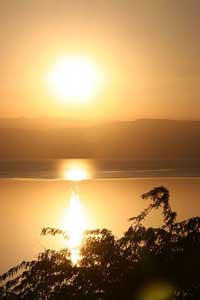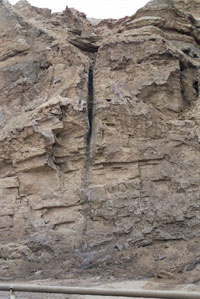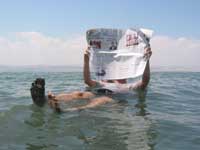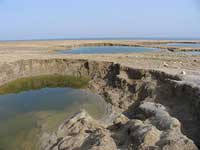Dead Sea
 |
| Dead Sea at Sunset (from Suwayma, Jordan) |
The Dead Sea is the Earth's lowest point not covered
by ice, at 418 m (1371 feet) below sea level and falling,
and the deepest hypersaline lake in the world, at 330 m (1083
feet) deep. It is the saltiest body of water on Earth, with
a salinity of about 30 percent. This is about 8.6 times greater
than average ocean salinity. It measures 67 km (42 miles)
long, 18 km (11 miles) wide at its widest point, and is located
on the border between the West Bank, Israel, and Jordan, and
lies in the Jordan Rift Valley. The main tributary is the
Jordan River.
The Dead Sea has attracted interest and visitors
from around the Mediterranean basin for thousands of years.
It was a place of refuge for King David, one of the world's
first health resorts (for Herod the Great), and it has been
the supplier of products as diverse as balms for Egyptian
mummification to potash for fertilizers.
In Hebrew the Dead Sea is called the Yam ha-Melakh
(help·info) - meaning "sea of salt," or Yam ha-Mavet, "sea
of death." In past times it was the "Eastern Sea" or the "Sea
of Arava." To the Greeks, the Dead Sea was "Lake Asphaltites"
(see below). In Arabic the Dead Sea is called al-Bahr al-Mayyit
(help·info) ("the Dead Sea"), or less commonly Bahr Lut ("the
Sea of Lot"). Historically, another Arabic name was the "Sea
of Zoar," after a nearby town.
 |
| Mount Sedom,
on the southwest side of the lake, is
a giant mountain of halite. |
Natural History
The Dead Sea is located in the Dead Sea Rift, which
is part of a long fissure in the Earth's surface called the
Great Rift Valley. The 6000 km (3700 mile) long Great Rift
Valley extends from the Taurus Mountains of Turkey to the
Zambezi Valley in southern Africa. The Great Rift Valley formed
in Miocene times as a result of the Arabian Plate moving northward
and then eastward away from the African Plate.
Around three million years ago what is now the valley
of the Jordan River, Dead Sea, and Wadi Arabah was repeatedly
inundated by waters from the Mediterranean Sea. The waters
formed in a narrow, crooked bay which was connected to the
sea through what is now the Jezreel Valley. The floods of
the valley came and went depending on long scale climatic
change. The lake that occupied the Dead Sea Rift, named "Lake
Sodom", deposited beds of salt, eventually coming to be 3
km (2 miles) thick.
According to geological theory, approximately two
million years ago the land between the Rift Valley and the
Mediterranean Sea rose to such an extent that the ocean could
no longer flood the area. Thus, the long bay became a long
lake.
The first such prehistoric lake is named "Lake Gomorrah."
Lake Gomorrah was a freshwater or brackish lake that extended
at least 80 km (50 miles) south of the current southern end
of the Dead Sea and 100 km (60 mi) north, well above the present
Hula Depression. As the climate turned more arid, Lake Gomorrah
shrank and became saltier. The large, saltwater predecessor
of the Dead Sea is called "Lake Lisan."
In prehistoric times great amounts of sediment collected
on the floor of Lake Gomorrah. The sediment was heavier than
the salt deposits and squeezed the salt deposits upwards into
what are now the Lisan Peninsula and Mount Sedom (on the southwest
side of the lake). "Geologists explain the effect in terms
of a bucket of mud into which a large flat stone is placed,
forcing the mud to creep up the sides of the pail". When the
floor of the Dead Sea dropped further due to tectonic forces
the salt mounts of Lisan and Mount Sedom stayed in place as
high cliffs. (see salt domes).
During 70,000 to 12,000 years ago the lake level
was a 100-250 m higher than its current level. This lake was
termed "Lake Lisan", which fluctuated dramatically with rising
to highest level around 26,000 years ago, indicating very
wet climate in the Near East. Sometime around 10,000 years
ago the lake level dropped dramatically, probably to levels
even lower than today. During the last several thousand years
the lake has fluctuated approximately 400 m with some significant
drops and rises.
The Jordan River is the only major stream flowing
into Dead Sea. There are no outlet streams.
The northern part of the Dead Sea receives scarcely
100 mm (4 in) of rain a year. The southern section barely
50 mm (2 in). The Dead Sea zone's aridity is due to the rainshadow
effect of the Judean Hills. The highlands east of the Dead
Sea receive more rainfall than the Dead Sea itself.
The mountains of the western side, the Judean Hills,
rise less steeply from the Dead Sea than do the mountains
of the eastern side. The mountains of the eastern side are
also much higher. Along the southwestern side of the lake
is a 210 m (700 ft) tall halite formation called "Mount Sedom".
Climatic Features
• Year-round sunny skies
• Dry, low polluted air
• Less than 50 mm mean annual rainfall
• Summer average temperature: 32 to 39 degrees Celsius
• Winter average temperature: 20 to 23 degrees Celsius
• Weakened UV radiation, particularly the UVB (erythrogenic
rays)
• High oxygen content due to the high barometric pressure
• The shore is lowest dry place in the world
Therapies popular at Dead Sea
• Climatotherapy:- Treatment which exploits
local climatic features such as temperature, humidity, sunshine,
Barometric pressure and special Atmospheric constituents.
• Heliotherapy:- Treatment that exploits the biological
effects of the sun's radiation.
• Thalassotherapy:- Treatment that exploits bathing
in Dead Sea water.
• Balneotherapy:- Treatment that exploits black mineral
mud of the Dead Sea.
 |
| A tourist demonstrates the unusual buoyancy caused by high salinity. |
Chemistry and health effects
Until the winter of 1978-1979, the Dead Sea was composed
of two stratified layers of water that differed in temperature,
density, age, and salinity. The topmost 35 meters or so of
the Dead Sea had a salinity that ranged between 300 and 400
parts per thousand and a temperature that swung between 19
°C (66 °F) and 37 °C (98 °F). Underneath a zone of transition,
the lowest level of the Dead Sea had waters of a consistent
22 °C (72 °F) temperature and complete saturation of sodium
chloride (NaCl).[citations needed] Since the water near the
bottom is saturated, the salt precipitates out of solution
onto the sea floor.
Beginning in the 1960s water inflow to the Dead Sea
from the Jordan River was reduced as a result of large-scale
irrigation and generally low rainfall. By 1975 the upper water
layer of the Dead Sea was actually saltier than the lower
layer. The upper layer nevertheless remained suspended above
the lower layer because its waters were warmer and thus less
dense. When the upper layer finally cooled down so that its
density was greater than the lower layer the waters of the
Dead Sea mixed. For the first time in centuries the lake was
a homogeneous body of water. Since then stratification has
begun to redevelop.
The mineral content of the Dead Sea is significantly
different from that of ocean water, consisting of approximately
53% magnesium chloride, 37% potassium chloride and 8% sodium
chloride (common salt) with the remainder comprised of various
trace elements.
The concentration of sulfate, SO42-, ions is very
low, and the bromide ion concentration is the highest of all
waters on Earth. Chlorides neutralize most of the calcium
ions in the Dead Sea and its surroundings. While in other
seas sodium chloride is 97% of the salts, in the Dead Sea
the quantity of NaCl is only 12-18%.
Comparison between the chemical composition of the
Dead Sea to other lakes and oceans show that the salt concentration
in the Dead Sea is 31.5% (the salinity fluctuates somewhat).
Because of its unusually high concentration of salt, anyone
can easily float in the Dead Sea because of natural buoyancy
as a result of the higher density of the water. In this aspect,
the Dead Sea is similar to the Great Salt Lake in Utah, in
the United States.
One of the most unusual properties of the Dead Sea
is its discharge of asphalt. From deep seeps, the Dead Sea
constantly spits up small pebbles of the black substance.
After earthquakes, chunks as large as houses may be produced.
The Dead Sea area has become a major center for health
research and treatment for several reasons. The mineral content
of the waters, the very low content of pollens and other allergens
in the atmosphere, the reduced ultraviolet component of solar
radiation, and the higher atmospheric pressure at this great
depth each have specific health effects. For example: persons
suffering reduced respiratory function from diseases such
as cystic fibrosis, seem to benefit from the increased atmospheric
pressure.
Sufferers of the skin disorder psoriasis also benefit
from the ability to sunbathe for long periods in the area
due to its position below sea level and subsequent result
that many of the sun's harmful UV rays are reduced.
 |
| Dead Sea in the morning, seen from Masada |
Flora and fauna
The sea is called "dead" because its high salinity
means no fish or macroscopic aquatic organisms can live in
it, though minuscule quantities of bacteria and microbial
fungi are present.
In times of flood the salt content of the Dead Sea
can drop from its usual 35% salinity to 30% or lower. In the
wakes of rainy winters the Dead Sea temporarily comes to life.
In 1980, after one such rainy winter, the normally dark blue
Dead Sea turned red. Researchers from Hebrew University found
the Dead Sea to be teeming with a type of algae called Dunaliella.
The Dunaliella in turn nourished carotenoid-containing (red-pigmented)
halobacteria whose presence is responsible for the color change.
Since 1980 the Dead Sea basin has been dry and the algae and
the bacteria have not returned in measurable numbers.
Many animal species make their homes in the mountains
surrounding the Dead Sea. A hiker can see camels, ibex, hares,
hyraxes, jackals, foxes, and even leopards. Hundreds of bird
species inhabit the zone as well. Both Jordan and Israel have
established nature reserves around the Dead Sea.
The delta of the Jordan river was formerly a veritable
jungle of papyrus and palm trees. Flavius Josephus described
Jericho as "the most fertile spot in Judea". In Roman and
Byzantine times sugarcane, henna, and sycamore all made the
lower Jordan valley quite wealthy. One of the most valuable
products produced by Jericho was the sap of the balsam tree,
which could be made into perfume. By the nineteenth century
Jericho's fertility was a thing of the past.
Human history
The human history of the Dead Sea goes all the way
back to remote antiquity. Just north of the Dead Sea is Jericho,
the oldest continually occupied town in the world. Somewhere,
perhaps on the Dead Sea's southeast shore, are the cities
mentioned in the Book of Genesis which were destroyed in the
times of Abraham: Sodom and Gomorra and the three other "Cities
of the Plain" - Admah, Zeboim and Zoar (Deuteronomy 29:23).
King David hid from Saul at Ein Gedi nearby.
The Greeks knew the Dead Sea as "Lake Asphaltites",
due to the naturally surfacing asphalt. Aristotle wrote about
the remarkable waters. During the Egyptian conquest it is
said that Queen Cleopatra obtained exclusive rights to build
cosmetic and pharmaceutical factories in the area. Later,
the Nabateans discovered the value of bitumen extracted from
the Dead Sea needed by the Egyptians for embalming their mummies.
Prominent personages linked with the Dead Sea and
its surroundings are Herod the Great, Jesus of Nazareth, and
John the Baptist. Also in Roman times some Essenes had settled
on the Dead Sea's western shore; Pliny the Elder identifies
their location with the words, "on the west side of the Dead
Sea, away from the coast ... the town of Engeda" (Natural
History, Bk 5.73); and it is therefore a hugely popular though
not uncontested hypothesis today, that same Essenes are identical
with the settlers at Qumran and that "the Dead Sea Scrolls"
discovered during the 20th century in the nearby caves had
been their own library.
King Herod the Great built/re-built several fortresses
and palaces on the Western Bank of the Dead Sea. The most
famous was Masada, where, in 66-70 AD, a small group of rebellious
Jewish zealots held out against the might of the Roman Legion,
and Machaerus where, it has been argued from the Gospel according
to Luke 3:20, that John the Baptist had been imprisoned by
Herod Antipas and met his death.
The remoteness of the region attracted Greek Orthodox
monks since the Byzantine era. Their monasteries such as Saint
George in Wadi Kelt and Mar Saba in the Judean Desert are
places of pilgrimage.
In Islamic tradition, the Dead Sea was about the
land in which the Prophet Lut (Lot in the Hebrew scriptures)
lived. His tribe had done wrong and had therefore been given
a punishment for such deeds. The punishment arrived when angels
were sent down by Allah to Lut. The angels raised the land
where the prophet's tribe lived and threw it back into the
ground, causing the ground near the impact to cave in. Thus,
the lowest land on Earth was formed because of this punishment.
The sinners were destroyed and the followers were saved.
Bedouin tribes have continuously lived in this area,
and more recently explorers and scientists arrived to analyze
the minerals and conduct research into the unique climate.
Since the 1960s, tourists from all the over world have also
explored the Dead Sea region.
Potash and salt works
In the early part of the 20th century, the Dead Sea
began to attract interest from chemists who deduced that the
Sea was a natural deposit of potash and bromine. The Palestine
Potash Company was chartered in 1929 (after its founder, Moses
Novomeysky, a Jewish engineer from Siberia, worked for the
charter for over ten years). The first plant was on the north
shore of the Dead Sea at Kalia and produced potash, or potassium
chloride, by solar evaporation of the brine. Employing Arabs
and Jews, it was an island of peace in turbulent times. The
company quickly grew into the largest industrial site in the
Middle East[citation needed] and in 1934 built a second plant
on the southwest shore, in the Sodom area, south of the 'Lashon'
region of the Dead Sea. The Dead Sea Works Ltd. was established
in 1952 as a state-owned company to extract potash and other
minerals from the Dead Sea.
From the Dead Sea brine, Israel produces (2001) 1.77
million tons potash, 206,000 tons elemental bromine, 44,900
tons caustic soda, 25,000 tons magnesium metal, and sodium
chloride. On the Jordanian side of the Dead Sea, the Arab
Potash Co. (APC), formed in 1956, produces 2.0 million tons
of potash annually, as well as sodium chloride and bromine.
Both companies use extensive salt evaporation pans that have
essentially diked the entire southern end of the Dead Sea
for the purpose of producing carnallite, potassium magnesium
chloride, which is then processed further to produce potassium
chloride. The power plant on the Israeli side allows production
of magnesium metal (by a subsidiary, Dead Sea Magnesium Ltd.).
The salt evaporation pans are visible from space.
 |
| Sinkholes at Mineral
Beach |
Recession of the Dead Sea
In recent decades, the Dead Sea has been rapidly
shrinking because of diversion of incoming water. From an
elevation of 395m below sea level in 1970 it fell 22m to 418m
below sea level in 2006, reaching a drop rate of 1m per year.
Although the Dead Sea may never entirely disappear, because
evaporation slows down as surface area decreases and salinity
increases, it is feared that the Dead Sea may substantially
change its characteristics.
The Dead Sea level drop has been followed by a groundwater
level drop, causing brines that used to occupy underground
layers near the shoreline to be flushed out by freshwater.
This is believed to be the cause of the recent appearance
of large sinkholes along the western shore – incoming freshwater
dissolves salt layers, rapidly creating subsurface cavities
that subsequently collapse to form these sinkholes.
Since it is not realistic to cease using the Jordan
River for human needs, one idea to save the Dead Sea is to
channel water from the Mediterranean or the Red Sea, either
through tunnels or canals. Although a Mediterranean structure
would be shorter, Israel is now committed to building a Red
Sea canal in deference to Jordan's needs. The plan is to pump
water 120 m up the Arava/Arabah from Aqaba or Eilat, tunnel
under the highest point of the Arava/Arabah valley, and then
canalize the river of seawater as it falls 520 m to the Dead
Sea. The desalination plant would be constructed in Jordan.
On May 9, 2005, Jordan, Israel, and the Palestinian
Authority signed an agreement to begin feasibility studies
on the project, to be officially known as the "Two Seas Canal".
The scheme calls for the production of 870 million cubic metres
of fresh water per year and 550 megawatts of electricity.
The World Bank is supportive of the project.
The road to the Dead Sea
The world's lowest road, Route 90 (Israel) runs along the Israeli and Palestinian (West Bank) shores of the Dead Sea at 393 m (1,289 ft) below sea level. This road was also made famous in Naomi Shemer's song Jerusalem of Gold.
In 1978, the shoreline was just 30 feet from the road. As of September 2006, the spa has to drive its guests a mile to the water. Visitors flock there to sightsee and bathe in mineral-rich waters. People who believe the Dead Sea is good for them will still go there on vacation. Nobody can say how much longer the sea will exist for tourists.
Water attractions
Besides the unique water of the Dead Sea itself, there are also health spas and hot springs along the shore. There is also the Israeli Atractziah Water Park (across from Kalia Kibbutz) and swimming pools in the large Hotel Resort.
Related global extremes
• West Antarctica's Don Juan Pond has a greater
salinity than the Dead Sea, at 18 times ocean salinity.
• The deepest point on the Earth's crust is the Mariana
Trench, a submarine trench in the western Pacific Ocean.
• There are ice-covered depressions on the continent
of Antarctica that are deeper than the Dead Sea (such as the
Bentley Subglacial Trench).
• The world's deepest lake is Lake Baikal in Siberia,
Russia.